Rotational Molding, also referred to as Rotomolding, is a developing process that is utilized to produce hollow plastic-type components. This procedure is acknowledged for its overall flexibility and is used in a number of market sectors, such as car, home furniture, leisure time, aerospace, and many more. So how does rotational molding operate, and the thing that makes it a common choice for several manufacturers? With this extensive manual, we shall demystify rotational molding and help you fully grasp all that you should learn about this production approach.
The whole process of Rotational Molding
Rotational molding involves utilizing a fungus which is shaped like the final product or service. The mildew is placed within a swivel cooker, and plastic-type material resin is included in it. The mold will then be rotated inside the oven, inducing the plastic-type resin to melt and stay with its surfaces. The mold is going to be cooled slowly to enable the plastic to create and undertake the contour of your mold. The concluded item is then ejected from your fungus, departing behind the hollow plastic aspect.
Features of Rotational Molding
Just about the most substantial advantages of rotational molding is its capability to produce big, hollow elements without seams or joints. The procedure is also very cost-effective, because it needs small tooling and gear. Rotational molding also enables utilizing a variety of materials, including polyethylene, polypropylene, and nylon, and others. Moreover, the procedure is highly personalized, permitting companies to create parts that meet their certain needs and requirements.
Applications of Rotational Molding
Rotomolding is commonly used in a variety of market sectors, such as automotive, home furniture, discretion, and aerospace, and others. Within the vehicle business, rotational molding is commonly used to make gasoline tanks, atmosphere ductwork, as well as other parts. The process is also employed to create kayaks, coolers, and other outside items. In addition, rotational molding can be used in the creation of health care products, for example prosthetics and dental implants.
Challenges in Rotational Molding
While rotational molding offers many advantages, furthermore, it features some challenges. One of the primary problems is preserving consistent wall surface fullness. Once the mildew is rotated, the plastic resin will gravitate toward the wall surfaces. This can lead to heavier wall space in a few areas of the part, which may lead to warping, cracking, or some other disorders. Suppliers make an effort to resolve this issue by adding a baffle within the mildew or by altering the rotation pace, amid other techniques.
Bottom line
Rotational molding has proved to be a flexible and cost-effective developing procedure, with applications across quite a few businesses. By demystifying this process, hopefully to obtain provided a greater knowledge of what rotational molding is and the way it could benefit your company. If you think that rotational molding might be right for you, consider looking into this production method in greater detail, and find an educated and experienced company that will help you take your perspective to our lives.
Bottom line:
In this information, we have supplied you with a thorough overview of rotational molding. You now recognize how this process functions, its pros and challenges, and the various uses of this producing method. Rotational molding continues to be a popular choice for several producers because of its overall flexibility, cost-effectiveness, and capacity to produce big, hollow elements with no seams or joint parts. Hopefully this article has helped you best comprehend the procedure of rotational molding, therefore we inspire one to consider this like a producing alternative for your forthcoming task.



